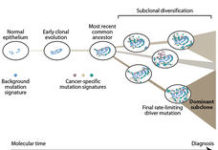The Southwest Oncology Group (SWOG) Cancer Research Network clinical trial S1616 is a randomised phase II study conducted to address whether CTLA4 blockade, alone or in combination with continued PD1 blockade, could reverse resistance to previous anti-PD1 therapy sequentially or concomitantly. All patients had advanced melanoma with primary resistance to anti-PD1 or anti-PD-L1. The study data support the hypothesis that outcomes are improved when introducing CTLA4 blockade with continuation of anti-PD1 therapy after progression versus switching to CTLA4 blockade therapy alone.
The authors believe that this study has implications for other cancers because it demonstrates an efficacy benefit with continued PD1 or PD-L1 blockade beyond progression compared to switching to a new agent. The findings are published by Dr. Ari VanderWalde of The West Clinic-Wolf River in Germantown, TN, US, Prof. Antoni Ribas of the Jonsson Comprehensive Cancer Center at the University of California in Los Angeles, CA, US, and colleagues on 17 August 2023 in the Nature Medicine.
The authors wrote in the background that at the time of the study design, treatment with PD1 blocking antibodies was the most widely used standard-of-care front-line therapy for patients with metastatic melanoma. The optimal therapeutic approach for patients who do not respond to initial single-agent anti-PD1 treatment is unclear. The study investigators reasoned that they could potentially reverse resistance by addressing the main mechanism of lack of response to PD1 blockade, that is, the absence of pre-existing intratumour T cell infiltrates. The concept of combined CTLA4 and PD1 blockade to reverse resistance to PD1 blockade alone is supported by three published clinical studies, one retrospective and two prospective.
All patients had advanced melanoma with primary resistance to anti-PD1 or anti-PD-L1 inhibitors, defined as tumours having no objective clinical response (complete or partial response) to the prior use of anti-PD1 or anti-PD-L1 blocking agents without intervening therapy for advanced disease, or with recurrence while on adjuvant anti-PD1 therapy. The primary endpoint was progression-free survival (PFS). Secondary endpoints included the difference in CD8 T cell infiltrate among responding and non-responding tumours, objective response rate, overall survival, and toxicity.
A 3:1 randomisation was used to power a secondary objective to evaluate changes in CD8 T cell infiltration of biopsies of patients in the combination group, requiring a larger number of patients receiving the combination. The investigators anticipated that the benefit of the combination would manifest itself through improved PFS mediated by increasing intratumour CD8 T cell infiltration on releasing the CTLA4 immune checkpoint with continued PD1 blockade therapy.
This study was open at 39 academic sites across the US. A total of 92 eligible patients were randomly assigned in a 3:1 ratio to receive the combination of ipilimumab and nivolumab, or ipilimumab alone. The combination of nivolumab and ipilimumab resulted in a statistically significant improvement in PFS over ipilimumab (hazard ratio 0.63, 90% confidence interval [CI] 0.41–0.97, one-sided p = 0.04).
Objective response rates were 28% (90% CI 19–38%) and 9% (90% CI 2–25%), respectively (one-sided p = 0.05). Grade 3 or higher treatment-related adverse events occurred in 57% and 35% of patients, which is consistent with the known toxicity profile of these regimens.
The analysis of baseline and on-therapy changes in CD8 T cell infiltration confirmed that CTLA4 blockade could result in increases in CD8 T cell infiltration in some cases with primary resistance to PD1 blockade. However, the changes in CD8 T cell infiltration observed in the present analysis did not reach statistical significance and thus, did not support the formal hypothesis tested as a secondary endpoint of this study.
The authors acknowledged several limitations to the S1616 study. With number of randomised patients, this study was not as large as other practice-changing studies. This was due to necessity because the combination of nivolumab and ipilimumab was frequently used as first-line treatment in melanoma clinics in the US, and doctors and patients needed to be willing to randomise to ipilimumab alone in second-line therapy when the combination of nivolumab and ipilimumab could be obtained outside the clinical trial. Although a PFS benefit was seen despite the small sample size, the small size made it difficult to perform meaningful subset analyses.
Due to the relatively long period between study conception and completion (approximately 6 years), certain standards and definitions changed during the study, notably the definition of primary resistance and available first-line therapies. A white paper published in 2020 defines primary progression slightly differently than in S1616 study and requires disease progression within 12 weeks after the last anti-PD1 dose.
Additionally, since the completion of enrolment in S1616 study, a new combination therapy in the first-line setting has been approved by the US Food and Drug Administration; the combination of nivolumab and the LAG3 blocking antibody relatlimab was demonstrated to have improved PFS compared to nivolumab alone. In S1616 study, very few patients received first-line combination therapy and none of these patients received relatlimab. As such, the utility of combining nivolumab and ipilimumab after progression on the combination of nivolumab and relatlimab is unknown.
At the time the S1616 study was developed, no optimal sequencing of BRAF plus MEK inhibitor therapy and immunotherapy had been determined. In S1616 study, only one patient with a BRAF mutation received BRAF plus MEK inhibitor targeted therapy before receiving any anti-PD1 therapy, while others did not receive BRAF inhibitor at all before enroling in the study. Since S1616 completed enrolment, the DREAMseq study demonstrated that BRAF plus MEK inhibitor therapy is less efficacious when given before immunotherapy in metastatic melanoma. An additional limitation of S1616 study is that the total number of patients with BRAF mutations is unknown because of lack of data collected prospectively.
Furthermore, despite the relatively large number of biopsies prospectively accrued and analyzed from patients enrolled in S1616, there was heterogeneity in the CD8 density assessment.
The authors wrote that their study serves as a proof of concept across tumour types and provides justification for investigators and drug developers to design studies in the second-line or later that include continued PD1 blockade even when the patient may have already progressed on PD1 blockade in a previous line. However, each combination will need to be tested individually because there is a potential that the combination of CTLA4 and PD1 blockade has synergistic effects that may not be evident with other combinations of PD1 blocking agents.
Bristol Myers Squibb provided investigational agents for the study. The study was funded by SWOG, US National Institutes of Health and National Cancer Institute grants. Biopsies and their analyses were supported by the Stand Up to Cancer (SU2C) Catalyst-Bristol Myers Squibb-American Association for Cancer Research grant.
Reference
VanderWalde A, Bellasea SL, Kendra KL, et al. Ipilimumab with or without nivolumab in PD-1 or PD-L1 blockade refractory metastatic melanoma: a randomized phase 2 trial. Nature Medicine; Published online 17 August 2023. DOI: https://doi.org/10.1038/s41591-023-02498-y







